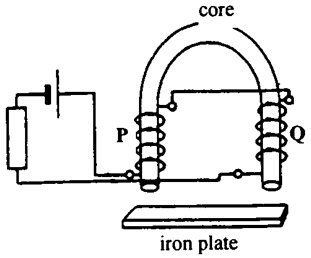Electromagnets
Edited by Tosin Emmanuel, Sharingknowledge, Jen Moreau, SarMal
An electromagnet consists of a soft iron core in a current carrying solenoid. The magnetic field strength is increased by the presence of the soft iron core or rod within the solenoid. An electromagnet is similar to a temporary magnet. An electromagnet can be made by winding the coils or solenoids is opposite directions around the two arms of a U-shaped soft iron core or bar.
Electromagnets are considered temporary magnets. When current flows from a battery around the solenoid, it is observed that the end of the U-shaped arm acts like the S(south)-pole, and the other end act like the N(north)-pole. This arrangement produces a strong magnetic field. However, magnetization and demagnetization occur rapidly when the current is switched on and off.
Applications
Electromagnets find many common applications in the industry including:
- Producing intense magnetic fields such as those required in generators and electric motors.
- Lifting and transporting heavy pieces of iron and steel; for example, steel plates.
- They can be used to separate iron from mixtures containing non-magnetic substances.
- They are used in the construction of such electromagnetic devices as the electric bell and telephone earpiece.
Electric Bell
When the button is pressed, the circuit of the system is complete and current flows around the electromagnet. The soft iron core becomes magnetized and the electromagnet attracts the soft iron armature attached to a spring, moving the hammer to strike the bell. The contact is broken as soon as the spring moving along with the soft iron armature breaks at the hammer's handle. The electromagnet then loses its magnetism and its attracting force of the spring, once again making contact at the hammer's handle. The circuit is re-established and current flows through the electromagnet once again. This sequence is repeated rapidly and the bell continues to ring as long as the bell push is pressed. The electric bell works on a 'make and break device. The contact between the spring and screw at the hammer's handle causes the hammer to move and strike the bell. The breaking of the contact at hammer's handle causes the hammer to leave the bell.
Telephone Earpiece
Before cell phones, traditional telephones relied on electromagnets to receive signals. The traditional telephone earpiece is a device which converts the varying electric energy from the microphone into varying sound energy.
The components are:
- 1The speech coils wound in opposite directions round two soft iron pole, placed at the south and north pole of a strong magnet M.Speech Coils.Advertisement
- 2A soft iron springy diaphragm made of magnetic alloy and located in front of the iron coresDiaphragm.
When a caller speaks into the microphone at one end of the line of communication, the varying sound energy from speech is converted into a varying speech current which is transmitted via a modulation and then demodulated at the receiver's side. The receiver listens to the demodulated signal via the earpiece. The variation in the electric current due to changes in the speech energy causes variation in the magnetism of the electromagnet. This varying magnetism of the electromagnet causes vibrations of the diaphragm placed in front of it. Vibration of the diaphragm creates sound waves of the same frequency in the air as the speech current and the speaker at the other end is heard.
Carbon Microphone
The first microphone invented was a carbon microphone. The carbon microphone appearance and mechanisms have largely remained unchanged and most of today's microphones have similar mechanisms. Sound microphones have two metal plates that are separated by small pieces of carbon. One plate is very thin and faces toward the speaking person, acting as a diaphragm. Sound vibration impinging on the diaphragm cause slight vibration of the diaphragm. This brings about some change in the pressure of the carbon granules causing corresponding changes in the resistance of the circuit sent through it by a battery. A speech current varying at the same frequency as the sound wave leaves the microphone through cables to the receiver at another telephone piece.
Referencing this Article
If you need to reference this article in your work, you can copy-paste the following depending on your required format:
APA (American Psychological Association)
Electromagnets. (2017). In ScienceAid. Retrieved Apr 20, 2024, from https://scienceaid.net/Electromagnets
MLA (Modern Language Association) "Electromagnets." ScienceAid, scienceaid.net/Electromagnets Accessed 20 Apr 2024.
Chicago / Turabian ScienceAid.net. "Electromagnets." Accessed Apr 20, 2024. https://scienceaid.net/Electromagnets.
If you have problems with any of the steps in this article, please ask a question for more help, or post in the comments section below.
Comments
Article Info
Categories : Physics
Recent edits by: Jen Moreau, Sharingknowledge, Tosin Emmanuel









